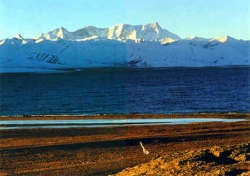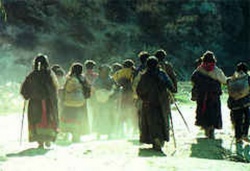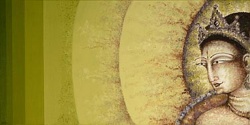System of Mountain Gods in Tibet
In ancient time, when some tribes merged into tribal groups, there were several Mountains in one area. Like a tribe which had its own leader, Gods in charge of these mountains also had their own leader. As a result, Four Major Mountain Gods came into being in the region. They were: Nyainqentanglha in northern Tibet.
Yag La Xiangpo in U-Tsang;
Ku La Rigyi in southern Tibet; and
Wodegungyai in eastern Tibet. Of the Four Major Mountain Gods, Yag La Xiangpo was the “leader of the leaders.”
WORSHIP ON MOUNTAINS
Imagine what one will worship in an environment isolated from the outside world by skyscraping peaks. Mountains, of course. Indeed, of things worshipped by the Tibetans, mountains are holy.
In the Tibet Autonomous Regions, snow-capped mountains are found everywhere. They are held as Reincarnation of Mountain Gods, and the Tibetans divided the Mountain Gods into good or Evil ones.
Some of the Mountain Gods are in charge of mild weather. At the foot of these mountains, there lie fertile farmland which spread far and wide. People there live on Hunting and livestock breeding. Such Mountain Gods are worshipped by the Tibetans.
In arid area, Mountain Gods often fly into a rage. When offended, they produce storms and hails. They are so fierce that the local people are scared.
According to the King Gesar, an epic, people from the Hor Tribe built a Mani stone mound at the mouth of the snow-capped Marqen Bamri Mountain. When people of the Ling Tribe got the news, they flew into a rage.
“Marqen Bamri is ours. How can people of the Hor Tribe build a Mani stone mound there?” they shouted.
Believing this meant invasion, people from the Ling Tribe decided to wage a tit-for-tat struggle. Ling troops were called out to blockade the mountain mouth, and Ling people went up the mountain to destroy the Mani stone mound. This touched off battles between the two tribes.
FOUR MAJOR MOUNTAIN GODS. In ancient time, various tribes lived separately, and didn’t have much contacts. Later, when some tribes merged into tribal groups, there were several Mountain Gods in one area. Like a tribe which had its own leader, Mountain God Groups also had leaders. As a result, Four Grand Mountain Gods appeared to rule other Mountain Gods in the region.
The Four Grand Mountain Gods appeared before Buddhism spread into Tibet. They were
Yag La Xiangpo in U-Tsang;
Nyainqentanglha in northern Tibet;
Ku La Rigyi in southern Tibet; and
Wodegungyai in eastern Tibet.
LEADER OF THE FOUR LEADERS. Of the Four Major Mountain Gods, Yag La Xiangpo was the “leader of the four leaders”. It gained the position mainly because the mountain (small when compared with others) is located in the area ruled by the Yarlung Siboye Tribe. The said tribe began to gain dominance in the 6th century in Shannan and Songtsan Gambo built the Tubo Kingdom in the early 7th century.
COLOR FAVORED BY MOUNTAIN GODS. The Tibetan race worships white color. In their eyes, white color is the most beautiful and holy. In legends, Mountain Gods are in white:
Yag La Xiangpo is a Mountain God in white. Riding a white yak, it produces snowstorm in its mouth and nostrils. It has the Power to destroy rocks and produce floods.
Nyainqentanglha, one of the four major Mountain Gods in U-Tsang, is also in white. It is worshipped as a Wealth Protecting God. [[File:Himalayas31.jpg |thumb|250px|]]The Anymarqen Mountain, towering over the Qinghai Lake, is a Mountain God hailed as the “Fighting Warrior”. It has a wife named Marichangri, leader of the 12 Goddess in Tibet. She, also in white, rides a white male deer. The beautiful goddess is in charge of hails.
TABOOS. Although the Tibetans began to worship mountains in the ancient time, the herders began to fear Mountain Gods in modern times.
One should not cough, whistle, speak loudly or make a piece of stone roll down the mountain for fear that he/she would invite storms or landslides.
One should not spit in the mountain gully, otherwise he/she would suffer from an illness.
One should not pass water at the Food of the mountain, otherwise he/she would suffer from pains.
One should not poke one’s finger into his/her nostrils, otherwise he/she would have neck troubles.
Many mountains in the Qinghai-Tibet Plateau are hailed as holy mountains which protect the people from being offended by the evils. Herders go worshipping Mountain Gods up in the mountains on a regular basis. In their eyes, rock form the skeleton of a Mountain God, mountain slope forms its skin and trees and grass are its Hair. As a result, they refrain from gathering firewood in mountains.
THE WAY TO WORSHIP MOUNTAIN GODS
Holy mountains are where people worship. Legend has it that walking around a holy mountain one time would help remove sins one commits during his lifetime; walking around it 10 times would help one stay away from sufferings in the hell.
One is lucky if he/she dies while taking ritual walk around a holy mountain.
Because of these beliefs, many come to worship holy mountains. Carrying luggages on backs, they come in twos or threes, prostrating themselves in front of these mountains. This is followed by their taking ritual walks which generally takes dozens of days. All along the way, they drink stream water and eat zanba (roasted highland barley flour). Their hands bleed, but they persist in walking, and walking. The luckiest people would hear auspicious sounds coming from afar at the cracks of ice mountains.


